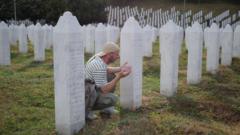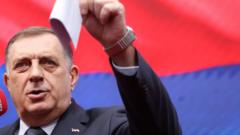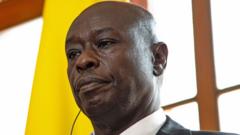More than eight thousand Bosnian men and boys were brutally murdered by Bosnian Serb forces in Srebrenica during July 1995, leaving scars that still resonate within Bosnia and Herzegovina today. The recent world premiere of "Flowers of Srebrenica" at Sarajevo’s War Theatre conveys the harrowing narrative of not just the massacre itself but the decades of unresolved grief that followed.
The Srebrenica massacre stands as a stark reminder of one of the most egregious war crimes in Europe since World War II. At that time, thousands of Bosniaks, primarily Muslim, sought refuge in Srebrenica, mistakenly believing it to be a safe haven under the protection of United Nations forces. However, instead of providing protection, Dutch troops stood by as General Ratko Mladić orchestrated the forced removal of women and children while overseeing the systematic execution of around 8,000 men and boys.
In the aftermath, the bodies of the deceased were buried in mass graves, only to be later exhumed and scattered across various sites in an attempt to hide the crime. This disorganization has led families to suffer endlessly, as identifying missing loved ones remains a lifelong struggle. DNA testing, however, has provided closure for some families who have been able to lay their relatives to rest in Potočari Cemetery.
The production of "Flowers of Srebrenica" encapsulates not only the historical events but also reflects the persistent divisions in modern Bosnian society. While the performance received heartfelt applause from the audience in Sarajevo, in majority-Serb Republika Srpska, political leaders maintain a narrative that denies the genocide, despite international court convictions for those responsible, including Mladić himself and Radovan Karadžić.
Lead actress Selma Alispahić, a former refugee from the conflict, voices her frustration at the continued denial of truth. "I thought that by now, we'd come to our senses," she remarked, expressing the exhaustion felt by many in the community who grapple with the ongoing fallout of war.
Despite the Dayton Peace Agreement that ended hostilities just months after the massacre, it also institutionalized ethnic divisions within the country, creating a fragmented political landscape. Recently, Milorad Dodik, the president of Republika Srpska, has taken actions to undermine national institutions and assert his entity's power, intensifying tensions with national authorities.
Christian Schmidt, the international High Representative for Bosnia, emphasizes the precariousness of the situation, calling for a stronger international military presence to ensure peace. While commemorations for the massacre are prevalent in Sarajevo, the sentiment diverges sharply in East Sarajevo, reflecting the underlying tensions and differing narratives.
As people gather to commemorate the events of Srebrenica, the fear of rising ethnic tensions looms large for many, including Mirela Osmanović, a local who lost family members during the massacre. The stark contrast in public sentiment between different regions illustrates a country still haunted by its past.
Ultimately, as political leaders engage in divisive rhetoric, the struggle for recognition, healing, and reconciliation continues to complicate the community's path toward a shared future.









